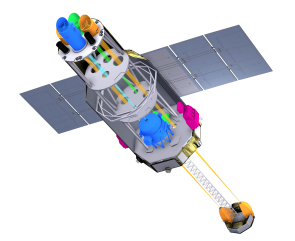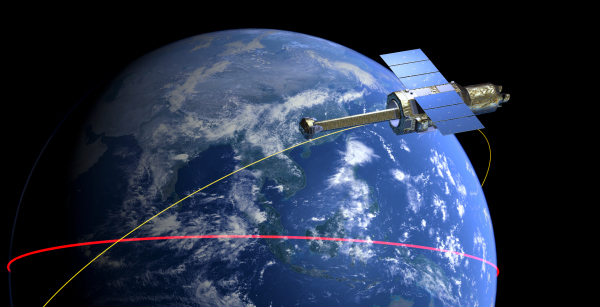Fact Sheet
 |
|
||||||||||||||
|
Hitomi (known as ASTRO-H prior to launch) is a high-energy astrophysics space observatory, developed by the Japan Aerospace Exploration Agency (JAXA) in collaboration with institutions in Japan, the US, Canada, and Europe.
 |
| The four instruments on Hitomi. Credit: JAXA |
This international observatory will study some of the most powerful phenomena in the Universe by probing the sky in the X-ray and gamma ray portions of the electromagnetic spectrum. With the new data, scientists will investigate extreme cosmic environments ranging from supernova explosions to supermassive black holes at the centre of distant galaxies, and the hot plasma permeating huge clusters of galaxies.
ESA contributed to Hitomi by partly funding some elements on the four science instruments, by providing three European scientists to serve as science advisors, and contributing one scientist to the team in Japan. In return for ESA's contribution, European scientists will be able to compete for about 8% of the observing time from this mission.
Mission Name
Traditionally, Japanese satellites for astronomy receive a provisional name consisting of the word ASTRO followed by a letter of the latin alphabet – in this case H, because it is the eighth project in JAXA's series of astronomical satellites. Following the successful launch of ASTRO-H on 17 February JAXA announced the mission's new name: Hitomi. This is a Japanese word used to describe the eye, and more specifically the pupil, or entrance window of the eye. The name Hitomi is also linked to an ancient legend about a painter drawing dragons.
Observatory
The Hitomi observatory comprises four telescopes: two Soft X-ray Telescopes (SXT) and two Hard X-ray Telescopes (HXT). The latter include a 6-m extendable boom that will be deployed once in orbit.
Some of the key characteristics of Hitomi are:
- The four telescopes on board are grazing-incidence reflecting telescopes. These consist of concentric, nested conical shells coated in reflecting material.
- There are 203 nested shells in each of the two Soft X-ray Telescopes (SXT), and 212 in each of the two Hard X-ray Telescopes (HXT).
- The energy range covered by the scientific instruments on Hitomi will be from about 0.3 keV to 600 keV (soft X-rays, hard X-rays and soft gamma rays). In comparison, ESA's XMM-Newton covers the energy range from 0.15 keV to 15 keV (soft and hard X-rays), NASA's Chandra X-ray Observatory from 0.08 keV to 10 keV (soft and hard X-rays), NASA's Nuclear Spectroscopic Telescope Array (NuSTAR) from 3 keV to 79 keV (hard X-rays), ESA's INTErnational Gamma-Ray Astrophysics Laboratory (INTEGRAL) from 3 keV to 10 MeV (hard X-rays and soft gamma rays) and the JAXA/NASA Suzaku satellite from 0.3 keV to 600 keV (soft X-rays, hard X-rays and soft gamma rays).
- The total observatory mass is 2700 kg, including 30 kg fuel.
Instruments
Hitomi carries four science instruments:
- Soft X-ray Spectrometer (SXS): A wide field (3' × 3') X-ray micro-calorimeter spectrometer covering energies from 0.3 keV to 12 keV; the energy resolution is better than 7 eV over the entire sensitive bandpass
- Soft X-ray Imager (SXI): A wide field (38' × 38') X-ray CCD camera covering energies from 0.4 keV to 12 keV
- Hard X-ray Imager (HXI): A wide field (9' × 9') Si/CdTe double-side detector covering energies from 5 keV to 80 keV
- Soft Gamma-ray Detector (SGD): A Si/CdTe Compton camera covering energies from 40 keV to 600 keV
Orbit
 |
| Artist's impression of Hitomi in orbit. Credit: JAXA |
Hitomi was launched on 17 February 2016 on an H-IIA rocket, which placed it in a circular low-Earth orbit, with altitude of about 575 km and inclination of 31°.
The mission will operate by performing pointed observations of each selected astronomical source until the total requested observing time is reached, and then slewing to the next selected source. Typical observations will require from a few tens to a few hundred thousand seconds, equivalent to a fraction of a day to a few days for the expected observational efficiency. All instruments are co-aligned and are, in principle, able to observe the same region of the sky at the same time.
Operations Centres
The Science Operations Centre for Hitomi will be located at the Institute of Space and Astronautical Science (ISAS, Kanagawa Prefecture Japan), while the Mission Operation Centres will be located at ISAS, at the Tsukuba Space Center (Ibaraki Prefecture, Japan), and at the Uchinoura Space Center (Kagoshima Prefecture, Japan). Two of the antennas used by Hitomi are located at the Uchinoura Space Center.
NASA's Goddard Space Flight Center (GSFC) has responsibility to develop the processing pipeline (based on the output of a pre-pipeline developed and run by JAXA) and the interactive data analysis software to be utilized by end users, as well as to run a Guest Observer Facility in support of the American Guest Observers after launch. Data will be archived and distributed from GSFC and ISAS.
European user activities are supported at two centres: the Science Operations Centre (SOC), located at the European Space Astronomy Centre (ESAC) in Spain, and the European Science Support Centre (ESSC), located at the ISDC Data Centre for Astrophysics, University of Geneva, Switzerland.
The SOC will focus on supporting the European scientific community in the use of the allocated time for Hitomi, through handling annual calls for observing proposals and related activities, and by supporting users with data analysis, taking advantage of the expertise that scientists at ESAC have for calibration and cross-calibration of high-energy astronomy missions.
The tasks of the ESSC are focussed on supporting the European scientific community with respect to the utilisation of Hitomi, providing expert knowledge about the observatory, training European astronomers, and contributing to the validation of the scientific quality of the calibrations in the analysis software.
